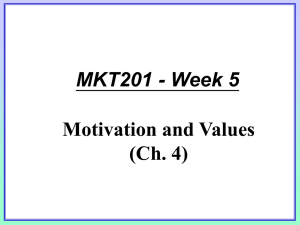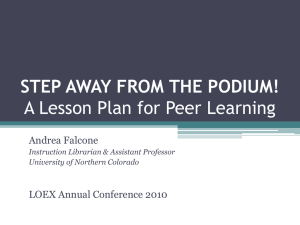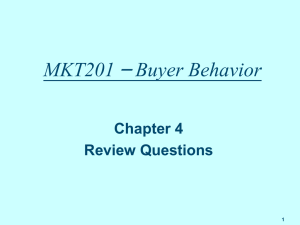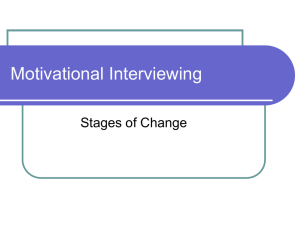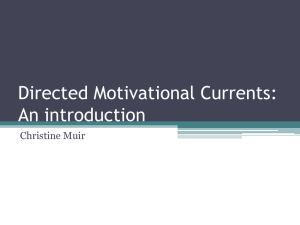PPT
advertisement
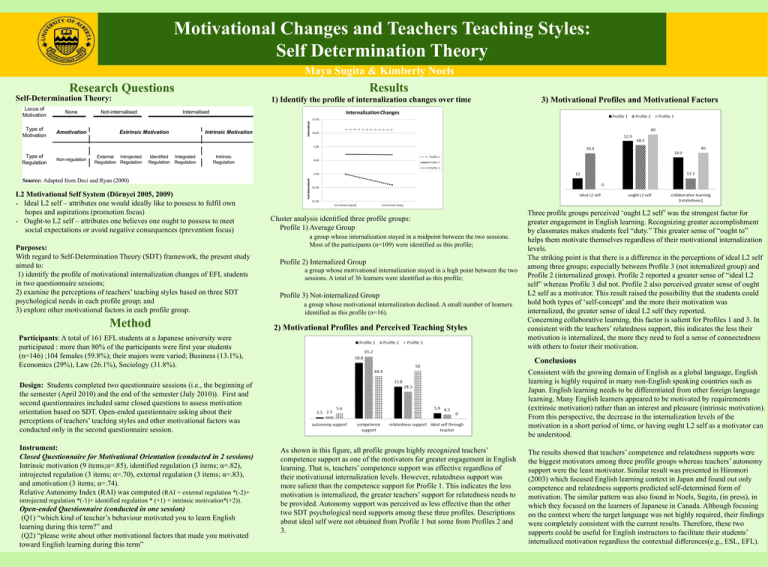
Motivational Changes and Teachers Teaching Styles: Self Determination Theory Maya Sugita & Kimberly Noels Results Research Questions Self-Determination Theory: L2 Motivational Self System (Dörnyei 2005, 2009) - Ideal L2 self – attributes one would ideally like to possess to fulfil own hopes and aspirations (promotion focus) - Ought-to L2 self – attributes one believes one ought to possess to meet social expectations or avoid negative consequences (prevention focus) Purposes: With regard to Self-Determination Theory (SDT) framework, the present study aimed to: 1) identify the profile of motivational internalization changes of EFL students in two questionnaire sessions; 2) examine the perceptions of teachers’ teaching styles based on three SDT psychological needs in each profile group; and 3) explore other motivational factors in each profile group. Method 1) Identify the profile of internalization changes over time Cluster analysis identified three profile groups: Profile 1) Average Group a group whose internalization stayed in a midpoint between the two sessions. Most of the participants (n=109) were identified as this profile; Profile 2) Internalized Group a group whose motivational internalization stayed in a high point between the two sessions. A total of 36 learners were identified as this profile; Profile 3) Not-internalized Group a group whose motivational internalization declined. A small number of learners identified as this profile (n=16). 2) Motivational Profiles and Perceived Teaching Styles Participants: A total of 161 EFL students at a Japanese university were participated : more than 80% of the participants were first year students (n=146) ;104 females (59.8%); their majors were varied; Business (13.1%), Economics (29%), Law (26.1%), Sociology (31.8%). introjected regulation *(-1)+ identified regulation * (+1) + intrinsic motivation*(+2)). Open-ended Questionnaire (conducted in one session) (Q1) “which kind of teacher’s behaviour motivated you to learn English learning during this term?” and (Q2) “please write about other motivational factors that made you motivated toward English learning during this term” Three profile groups perceived ‘ought L2 self’ was the strongest factor for greater engagement in English learning. Recognizing greater accomplishment by classmates makes students feel “duty.” This greater sense of “ought to” helps them motivate themselves regardless of their motivational internalization levels. The striking point is that there is a difference in the perceptions of ideal L2 self among three groups; especially between Profile 3 (not internalized group) and Profile 2 (internalized group). Profile 2 reported a greater sense of “ideal L2 self” whereas Profile 3 did not. Profile 2 also perceived greater sense of ought L2 self as a motivator. This result raised the possibility that the students could hold both types of ‘self-concept’ and the more their motivation was internalized, the greater sense of ideal L2 self they reported. Concerning collaborative learning, this factor is salient for Profiles 1 and 3. In consistent with the teachers’ relatedness support, this indicates the less their motivation is internalized, the more they need to feel a sense of connectedness with others to foster their motivation. Conclusions Consistent with the growing domain of English as a global language, English learning is highly required in many non-English speaking countries such as Japan. English learning needs to be differentiated from other foreign language learning. Many English learners appeared to be motivated by requirements (extrinsic motivation) rather than an interest and pleasure (intrinsic motivation). From this perspective, the decrease in the internalization levels of the motivation in a short period of time, or having ought L2 self as a motivator can be understood. Design: Students completed two questionnaire sessions (i.e., the beginning of the semester (April 2010) and the end of the semester (July 2010)). First and second questionnaires included same closed questions to assess motivation orientation based on SDT. Open-ended questionnaire asking about their perceptions of teachers’ teaching styles and other motivational factors was conducted only in the second questionnaire session. Instrument: Closed Questionnaire for Motivational Orientation (conducted in 2 sessions) Intrinsic motivation (9 items;α=.85), identified regulation (3 items; α=.82), introjected regulation (3 items; α=.70), external regulation (3 items; α=.83), and amotivation (3 items; α=.74). Relative Autonomy Index (RAI) was computed (RAI = external regulation *(-2)+ 3) Motivational Profiles and Motivational Factors As shown in this figure, all profile groups highly recognized teachers’ competence support as one of the motivators for greater engagement in English learning. That is, teachers’ competence support was effective regardless of their motivational internalization levels. However, relatedness support was more salient than the competence support for Profile 1. This indicates the less motivation is internalized, the greater teachers’ support for relatedness needs to be provided. Autonomy support was perceived as less effective than the other two SDT psychological need supports among these three profiles. Descriptions about ideal self were not obtained from Profile 1 but some from Profiles 2 and 3. The results showed that teachers’ competence and relatedness supports were the biggest motivators among three profile groups whereas teachers’ autonomy support were the least motivator. Similar result was presented in Hiromori (2003) which focused English learning context in Japan and found out only competence and relatedness supports predicted self-determined form of motivation. The similar pattern was also found in Noels, Sugita, (in press), in which they focused on the learners of Japanese in Canada. Although focusing on the context where the target language was not highly required, their findings were completely consistent with the current results. Therefore, these two supports could be useful for English instructors to facilitate their students’ internalized motivation regardless the contextual differences(e.g., ESL, EFL).



